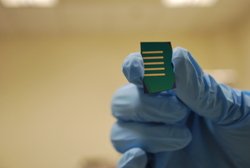Sep 4 2010
A pioneering study by researchers of The Hong Kong Polytechnic University (PolyU) has shown that sandwiching a simple layer of silver nanoparticles can significantly improve the performance of organic transistors which are commonly used in consumer electronics.
This revolutionary breakthrough is expected to cut down the cost of memory devices such as touchscreens and e-books and improve their performance.
 Organic thin-film transistor memory device
Organic thin-film transistor memory device
This cutting-edge research is led by Dr Paddy Chan Kwok-leung, Assistant Professor of the Department of Mechanical Engineering, and Dr Leung Chi-wah, Assistant Professor of the Department of Applied Physics, with postdoctoral research fellow Dr Sumei Wang as one of the key members. The finding was printed in the latest issue (August 2010) of the authoritative journal Applied Physics Letters published by the American Institute of Physics, and has been featured in ScienceDaily. This work will also be presented in the September issue of Chemical Engineering Progress, a publication of the American Institute of Chemical Engineers.
Organic transistor involves the use of organic semiconducting compounds in electronic component. It is a key part of electronic devices like touchscreens. Computer displays enabled by organic transistors are bright with vivid colours. They also provide fast response time and are easy to read in most ambient lighting condition. With the appropriate use of nanotechnology, the performance of organic transistors can be further improved and their size can be made thinner. The novel method developed by PolyU researchers is much more compatible with the low-cost, continuous roll-to-roll fabrication techniques used to make organic electronics.
More importantly, Dr Chan and his co-researchers have shown that the thickness of the nanoparticle layer changes the memory device performance in a more predictable way and thereby optimizing transistor performance to meet application requirements. Organic transistors made with a 1-nanometer nanoparticle layer have stable memory which lasts for three hours, making it suitable for memory buffers. And transistors with a 5-nanometer-thick layer can retain their charge for a much longer time.
PolyU researchers anticipate a very high potential for the use of organic memory in next-generation memory devices because of its flexibility and relatively low cost.
Source: http://www.polyu.edu.hk/